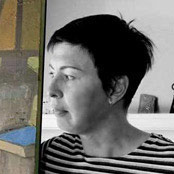Beyond the Glance: Elena Zolotnitsky
Winslow Myers
Meditating in paint on the trembling vulnerability of adolescents, flowers, or ripening pears, Elena Zolotnitsky evokes their archetypal forms out of subtle and daring tonal contrasts, modest scale, and the rough passage of the brush across the tooth of the paper or canvas surface. She sees her motifs not merely as a means but as an end, not just a descriptive forming of an “it,” but a poetic evocation of a “thou.” In every case the result is a painting, not a mere description, that transcends and freshens the chosen genre. This achievement requires constant self-renewal in the process of working. One sign of good painters is that they don’t have a gimmick. They face themselves, the canvas—and us—with a salutary nakedness.
After a century of non-figurative art, the process of representational painting itself has become what Harold Rosenberg, referring to the “action painting” of someone like de Kooning, called “an arena in which to act.” The result can transcend the falsely separate categories of figuration and abstraction. We see a serene realization of this possibility in the work of Morandi, or a more dynamic version in Richard Deibenkorn. Such artists have educated our eyes to be more attuned to the “look” of the figurative image, the response that comes from the first immediate glance, rather than to the sentiment that may arise from any possible narrative implied by the image. The poetic vibration in Zolotnitsky’s work arises from the certainty that every stroke of paint is put down for the benefit of the work as a whole and not merely to describe a given form.
But when the painting itself does in fact become the subject, there is a completion of the circle. The abstraction in Deibenkorn’s “Ocean Park” series or a Wallace Stevens poem, instead of turning in upon itself, ends by revealing something new about the reality that is its initial source. What holds us beyond the “look” of the abstraction is something half-intuited, but eventually fully realized and alive, a surprising extension into new realms of experience. Zolotnitsky’s subjects do not disappear into the cropped abstraction of her compositions. Instead their psychology is revealed and intensified by the tightness of the design. It is as if her models were no longer under the spell of that tried but true cliché of art history, the authority of the male gaze. Instead they return the gaze of the viewer with features both apprehensive about and eager for what calls out to them from the future—their own veiled fate. In the same way, what Zolotnitsky might paint next may be veiled even to her, and yet that unknown is implicit in her already considerable accomplishment.
Winslow Myers is a writer and painter who lives in Jamaica Plain, MA. His work can be seen on line at www.winslowmyers.com

